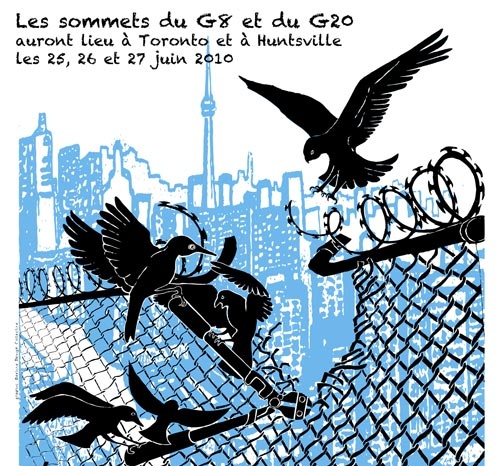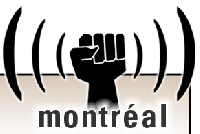 |
 |
 |
 |
 |
 |
|
 |
 |
 |
 |
 |
 |
 |
Régions du Québec |  |
 |
 |
|
 |
 |
|
 |
 |
|
 |
 |
 |
 |
 |
 |
Rubriques (sujets) |  |
 |
 |
|
 |
 |
|
 |
|
 |
 |
 |
Bhopal: Holding Corporate Terrorists Accountable
On 3rd December 1984, poison gas leaked from a Union Carbide factory, killing thousands... people are still perishing at the rate of one a day from injuries sustained over eighteen years ago...
At noon on May 1, two Indian women, watched by a crowd of sympathizers, seated themselves on the sidewalk under the bull statue on Wall Street to begin "a fast unto death." Rasheeda Bee and Champa Devi Shukla are survivors of what the people of Bhopal still refer to as "that night."
On 3rd December 1984, poison gas leaked from a Union Carbide factory, killing thousands. How many thousands, no one knows. Carbide says 3,800. Municipal workers who picked up bodies with their own hands, loading them onto trucks for burial in mass graves or to be burned on mass pyres, reckon they shifted at least 15,000 bodies. Survivors, basing their estimates on the number of shrouds sold in the city, conservatively claim about 8,000 died in the first week. Such body counts become meaningless when you know that the dying has never stopped.
The two women are on hunger-strike "to highlight the truth behind Dow Chemical and Union Carbide's liabilities in Bhopal," where people are still perishing at the rate of one a day from injuries sustained over eighteen years ago. Since the disaster, the city has experienced epidemics of cancers, menstrual disorders and what one doctor described as "monstrous births."
Treatment protocols are hampered by the company's continuing refusal to share information it holds on the toxic effects of MIC – the gas that leaked. Union Carbide and its new owner Dow Chemical claim the data is a "trade secret." For twelve years the company's executives have also been ignoring the summons of a Bhopal court to answer criminal charges of "culpable homicide" for a death-toll that continues to mount and which, according to Indian government figures, has now climbed past 20,000.
Meanwhile a new generation is being poisoned by chemicals abandoned by the company at its now-derelict factory. In December 1999, Greenpeace reported that soil and water in and around the plant were contaminated by organochlorines and heavy metals. A February 2002 study found mercury, lead and organochlorines in the breast milk of women living near the plant.
Says hunger-striker Bee, who lost five gas-exposed family members to cancers, was herself partially blinded and still suffers from psychiatric and respiratory problems, "A hunger strike is our way of emphasizing the truth that the tragedy in Bhopal continues, and that Dow as Carbide's new owner is now responsible for ensuring that justice is done.
Fasting with Bee and Shukla in New York is Bhopal activist Satinath Sarangi. Supporters around the world are undertaking shorter hunger-strikes in sympathy. Among those pledged to fast indefinitely is Diane Wilson, a shrimp-boat captain and environmental campaigner from Texas. Last July, she went without food for twenty-eight days outside a Dow chemical plant formerly owned by Union Carbide, ending her protest by climbing over the fence and chaining herself 70 feet up a tower, from which she draped a banner saying "Dow is responsible for Bhopal."
Wilson was forcibly removed by an armed SWAT team. Despite the fact that her protest was entirely peaceful and caused no damage, Dow bosses gave interviews indicating that they regarded her as little short of a terrorist and said she would be rigorously prosecuted. The irony that they themselves are refusing to appear in a court where they are wanted for mass homidice, entirely escaped them.
There is a deeper irony. Consider for a moment what terror is: "extreme fear, fear that agitates body and mind, violent dread" and that which causes and excites these feelings. This is how Webster's Dictionary defines terror. On the night of Dec. 3, 1984, Bee, Devi and many thousands of others, suffered terror beyond definition.
Remembers Aziza Sultan, a survivor: "At about 12.30 am I woke to the sound of my baby coughing badly. In the half light I saw that the room was filled with a white cloud. I heard a lot of people shouting. They were shouting 'run, run'. Then I started coughing with each breath seeming as if I was breathing in fire. My eyes were burning."
One of the hunger strikers, Champa Devi Shukla, remembers that "It felt like somebody had filled our bodies up with red chillies, our eyes tears coming out, noses were watering, we had froth in our mouths. The coughing was so bad that people were writhing in pain. Some people just got up and ran in whatever they were wearing or even if they were wearing nothing at all. Somebody was running this way and somebody was running that way, some people were just running in their underclothes. People were only concerned as to how they would save their lives so they just ran.
"Those who fell were not picked up by anybody, they just kept falling, and were trampled on by other people. People climbed and scrambled over each other to save their lives – even cows were running and trying to save their lives and crushing people as they ran."
In those apocalyptic moments no one knew what was happening. People simply started dying in the most hideous ways. Some vomited uncontrollably, went into convulsions and fell dead. Others choked to death, drowning in their own body fluids. Many died in the stampedes through narrow gullies where street lamps burned a dim brown through clouds of gas.
"The force of the human torrent wrenched children's hands from their parents' grasp. Familes were whirled apart," reported the Bhopal Medical Appeal in 1994. "The poison cloud was so dense and searing that people were reduced to near blindness. As they gasped for breath its effects grew ever more suffocating. The gases burned the tissues of their eyes and lungs and attacked their nervous systems. People lost control of their bodies. Urine and faeces ran down their legs. Women lost their unborn children as they ran, their wombs spontaneously opening in bloody abortion."
Terror – real, deadly and beyond words – was visited on the people of Bhopal. Who caused that terror? The survivors of Bhopal continue to feel "extreme fear, fear that agitates body and mind, violent dread," because they don't know what horrors may yet emerge in their bodies. Who continues to deny them medical information that could help? The people of Bhopal want justice in a court of law. Who sneers at justice by refusing to appear in court? Terrorists are by definition those who cause terror, who have no respect for law and justice.
When grief turns to anger, when your rage is as useless as your tears, when those in power become blind, deaf and dumb in your presence, when the rest of the world has forgotten you, what are you to do? Must you put away your anger, choke back your bitterness, and cultivate patience, in the hope that justice will eventually prevail? What if the very government that is supposed to protect you cynically manipulates the law against you, what use then is the law, with all its guarantees? Must you still obey it, while your opponents twist it to whatever they please?
If the law is useless, whispers despair, then does it any longer matter if you go outside it? What else is left? Violent answers to such questions are seen nightly on our TV screens. The hunger-strikers of Bhopal make a different reply – that of Gandhiji who said, "Non-violence is a more active and real fight against wickedness." Having nothing, they give their own bodies. They entrust their lives to other people's sense of justice. Yours, mine, all of ours.
On May 8, their eighth day without food, Rasheeda, Champa and Sathyu will be in Midland, Michigan, where Dow shareholders are meeting. We should all be there – in spirit if not in person – to support them and add our own voices to their demand that justice be done in Bhopal.
Indra Sinha is a novelist who lives in England. He has been involved with the Bhopal justice campaign for the last ten years.
 |
 |
 |
 |
Dossier G20 |  |
 |
 |
|
 |
 |
|
 |
Nous vous offrons plusieurs reportages indépendants et témoignages...

Liste des activités lors de ce « contre-sommet » à Toronto Vous pouvez aussi visiter ces médias alternatifs anglophones... Centre des médias Alternatifs Toronto 2010.mediacoop.net Media Co-op Toronto http://toronto.mediacoop.ca Toronto Community Mobilization www.attacktheroots.net (en Anglais) |
 |
 |
 |
 |
 |
 |
 |
CMAQ: Vie associative |  |
 |
 |
|
 |
 |
|
 |
 Collectif à Québec: n'existe plus. Impliquez-vous ! |
 |
 |
 |
 |
 |
 |
 |
 |
|
 |
 |
 |
Ceci est un média alternatif de publication ouverte. Le collectif CMAQ, qui gère la validation des contributions sur le Indymedia-Québec, n'endosse aucunement les propos et ne juge pas de la véracité des informations. Ce sont les commentaires des Internautes, comme vous, qui servent à évaluer la qualité de l'information. Nous avons néanmoins une
Politique éditoriale
, qui essentiellement demande que les contributions portent sur une question d'émancipation et ne proviennent pas de médias commerciaux.
This is an alternative media using open publishing. The CMAQ collective, who validates the posts submitted on the Indymedia-Quebec, does not endorse in any way the opinions and statements and does not judge if the information is correct or true. The quality of the information is evaluated by the comments from Internet surfers, like yourself. We nonetheless have an
Editorial Policy
, which essentially requires that posts be related to questions of emancipation and does not come from a commercial media.


